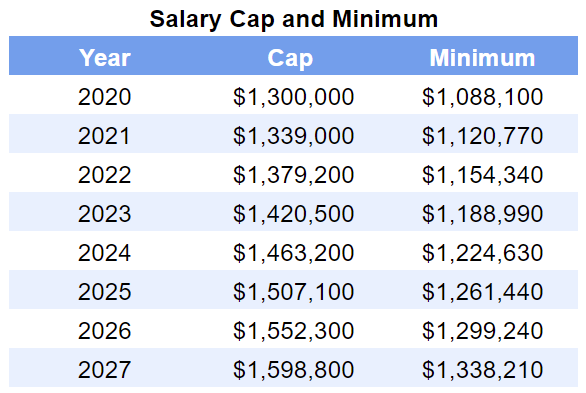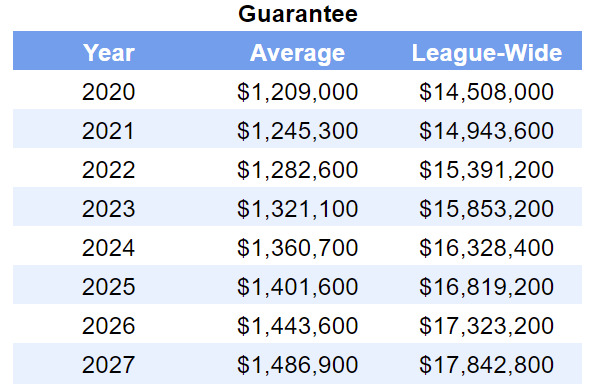WNBA CBA & Salary Cap Explained: Cap Basics
What is the WNBA salary cap, what counts on the cap, and what happens if players aren't paid enough?
Thanks for reading the Her Hoop Stats Newsletter. If you like our work, be sure to check out our stats site, our podcast, and our social media accounts on Twitter, Facebook, and Instagram. You can also buy Her Hoop Stats gear, such as laptop stickers, mugs, and shirts!
Haven’t subscribed to the Her Hoop Stats Newsletter yet?
Welcome back to our WNBA CBA and Salary Cap Explained series. As part of our mission to unlock better insight about the women’s game, we’re breaking down the rules outlined in the 350-page WNBA Collective Bargaining Agreement (CBA), covering the 2020 through 2027 seasons, in plain language. Each article will focus on a bite-size chunk of the CBA to make the concepts more digestible. To catch up on the previous six pieces in the series, check out the list at the bottom of this piece. We are also compiling all of this information on the Her Hoop Stats website in a single FAQ document.
This is the first installment covering the league’s salary cap and how teams are required to operate their salaries to comply with the cap. This piece will cover the basics of the salary cap, including the levels of the salary cap, league guarantee, and team minimum. The next piece will cover what happens to a team’s salary with retirements, hold-outs, and training camp contracts, among other unique circumstances.
What are the salary cap and team minimum?
The salary cap is the maximum allowed total salary of all the players a team has on the books. The WNBA is different from most other professional sports leagues in the US in that the salary cap is a hard cap with very little wiggle room. The only time during the regular season that a team can go above the salary cap is for hardship or emergency hardship exceptions, which we discussed in our previous piece.

Under the latest CBA, the salary cap is fixed for each season through 2027 with annual increases of 3% each season. The minimum team salary level increases at the same rate. With a few exceptions, this is about in line with the maximum increase a contract can see in each season. The minimum team salary, which works out as 83.7% of the salary cap, is the minimum total salary a team can have by the end of each season. Teams may be below the minimum before the season and throughout the season with no penalty.
What counts on a team’s salary?
A team’s total salary includes the salary, expected time off bonuses, and any trade bonuses that have been exercised for players currently under contract. Outstanding qualifying offers and offer sheets, money owed to retired players, cap holds for rosters under 10 players, and any guaranteed or buyout money from cut players is also included. As mentioned earlier, replacement contracts that are signed from the hardship exception do count on the salary cap but a team with a hardship exception can go over the cap.
Contracts of players who are no longer with the team do not count against a team’s salary, with the exception of players who are owed money after being cut, as noted above. This means that players who are traded to a new team are no longer counted on their old team’s salary cap. Seven-day contracts do count on a team’s total salary, but seven-day contracts must terminate before the season ends, so they are irrelevant to the team minimum.
What happens if a team finishes below the team minimum?
If a team finishes the season below the minimum team salary, it must make payments to all players who are currently on the team. The Players Association is tasked with determining a reasonable way to divide that money, known as the “shortfall.” It is mentioned, but not required, that the payments may be in proportion to salary. These payments are not really a penalty, because the team doesn’t pay any sort of additional fine. Thus, a team has no financial incentive to sign a player at the end of the season just to meet the minimum.
For example, if the Chicago Sky’s team salary at the end of the 2020 season was only $1,050,000 then the team would have to pay out an additional $38,100. In that scenario, Allie Quigley’s $200,000 salary would be 19% of Chicago’s team salary, and Azura Stevens’ $57,000 would account for 5.4% of the total. If the Players Association opted for proportional payments, Quigley would be paid an additional $7,257 and Stevens would be paid $2,068.
What is the guarantee level?
The guarantee level, which is about seven percent below the salary cap, is the average team salary that the league guarantees to pay to their players. This specific number is not directly important for individual teams, because the total guarantee is the guarantee level multiplied by the number of teams in the league. So, for 2020, this means the league is guaranteeing that it will pay out at least $1,209,000 multiplied by 12 for a total of $14,508,000. This guarantee level is based on all contracts that count on a team’s salary by the conclusion of the season.

What happens if the guarantee level is not met?
If the guarantee level is not met at the end of the season, the league must make payments to all players who were on a roster during that regular season in order to reach the league-wide guarantee level. Just as with the team minimum, the Players Association is tasked with determining a reasonable way to divide that money, known as the “shortfall”, within 30 days of the end of the season. The payment must be made by the league within 60 days of the end of the season.
For example, if the sum of all team salaries at the end of the 2020 season, including payments from teams below the team minimum, was only $14,000,000 then the league would have to pay out an additional $508,000. In that scenario, Allie Quigley’s $200,000 salary would be 1.43% of the total salaries, and Azura Stevens’ $57,000 would account for 0.04% of the total. If the Players Association opted for proportional payments, Quigley would be paid approximately $7,257 and Stevens would be paid $2,068.
Do team minimum shortfalls affect the league-wide guarantee?
Yes, they do. The amount a team pays out due to being below the team minimum is included when figuring out the league-wide salary and if the guarantee level has been reached. This means if the league has total salaries that are $100,000 below the league-wide guarantee, but one team has to pay a shortfall of $150,000 to reach the team minimum, then the league’s total salaries would also rise by $150,000 and take the league over the guarantee level.
Missed our previous installments? Here are all the topics we have covered so far…
This series is about learning, so we want to hear from you! If you would like a clarification for any rule, suggestions for future CBA Explained topics, or any other questions, please feel free to let us know in the comments or tweet at us @herhoopstats.
Thanks for reading the Her Hoop Stats Newsletter. If you like our work, be sure to check out our stats site, our podcast, and our social media accounts on Twitter, Facebook, and Instagram.




Re: the guarantee level- is it something the league pays players on top of their salaries? So even if Chicago meets the minimum salary but the league as a whole doesn’t, Sky players would get more money?